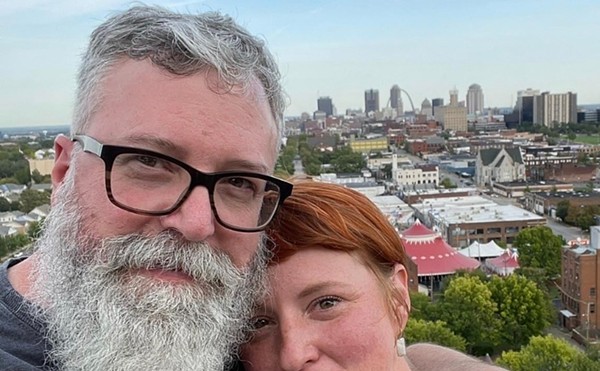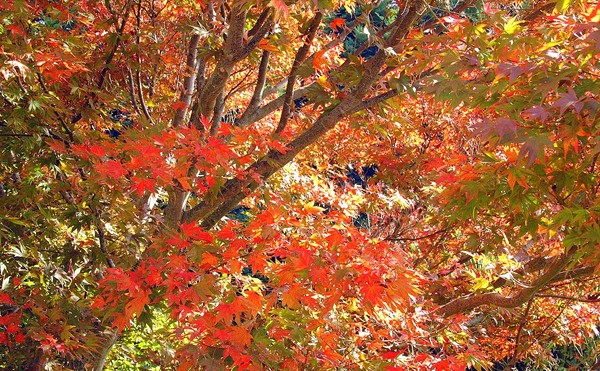Joel Meyerowitz, Vintage/Modern: Color Work 1976-2008 Reviewed in this issue.
Ongoing
Jill Downen: Hard Hat Optional A hybrid of supple and severe forms, this installation of pristine plaster shapes and construction-grade pine resembles a studio work in progress or the foundational disarray of a building site. Bright white half-figural shapes sit on freshly assembled crates; two-by-fours bolted into the gallery wall project into the space what could be the initial framework for a ceiling. Sandbags sag, fiberboard leans, molded objects pucker and dimple — dialectics, here, abound: between the body and buildings, order and disorder, the newly made and the softly aged. Standing amid the piece, the viewer is invited into a game of visual volleying of apparently — but perhaps not absolutely — widely suggestive oppositional tensions. Also showing: Chris Rubin de la Borbolla: there was a silent tinfoil rapping against the front door and Brett Williams: Things You Will See. Through May 9 at Bruno David Gallery, 3721 Washington Boulevard; 314-531-3030 or www.brunodavidgallery.com. Hours: 10 a.m.-5 p.m. Wed.-Sat., noon the first Sun. of every month and by appointment.
American Interiors: Photographs by David R. Hanlon These oblique photographs of unpopulated interiors capture the peculiar poetics of immemorial interior spaces occupied by the spirit of waiting rooms during off-hours. Hotel lobbies, hotel rooms, conference quarters and assorted landings — while each space is viewed as though through a peripheral glance, the photographs themselves are pieces of meticulous and exquisite craft. The series forms an observational catalogue of mass-fabricated materials — Roll-A-Tex, doily-patterned bed shams, paisley wallpaper trim and matching wall-to-wall carpet — forlorn in its lack of history. Yet each discrete image suggests vague cinematic potential — as though some daily but resonant drama just occurred or is about to, illuminated by office-grade fluorescence or the sober light of day. Through May 23 at the Sheldon Art Galleries, 3648 Washington Boulevard; 314-533-9900 or www.thesheldon.org. Hours: noon-8 p.m. Tue., noon-5 p.m. Wed.-Fri., 10 a.m.-2 p.m. Sat.
Tony Fitzpatrick: The City Etchings 1993-2003 This series of line renderings of imaginary cartoon icons haloed, Virgin of Guadalupe-style, in carnivalesque heaps of urban artifacts has the intimate, serial quality of daily entries in a notebook and the imagistic content of an illuminated manuscript drawn by a dime-store comic-book artist. With its raw emotional breadth, the work, which negotiates the passing of Fitzpatrick's father, defies this Chicago-born artist's tough-guy persona. The specter of Philip Guston looms large here, manifested in a spirit of wryly internalized loss, Piero della Francesca compositions, and the form of tragicomic characters like hooded Klansmen and blank De Chirico-esque faces. Fitzpatrick adds to this surreal cast with representative symbols of a personally fabled Chicagoland — teetering skyscrapers, water towers and tangles of train track — and that region's immigrant, working-class Catholicism and weather-worn survivalism. Hands clasped in prayer and wrapped in barbed wire float above a clip-art goose or a weeping robot against a shallow backdrop of iron bridges and piled brick. Despite the proliferation of imagistic references, the cumulative effect is honorific, nostalgic and ultimately Fitzpatrick's: a small riffraff world trying to hustle away the irrevocable with the eternal promise of art. Through May 23 at Gallery 210, TeleCommunity Center, University of Missouri-St. Louis, 1 University Drive (at Natural Bridge Road); 314-516-5976 or www.umsl.edu/~gallery. Hours: 11 a.m.-5 p.m. Tue.-Sat.
Ideal (Dis-) Placements: Old Masters at the Pulitzer This exhibition of canonical canvases of slain martyrs, pious virgins and other grand dilemmas borrowed from two encyclopedic museums and replaced in naturally lit contemporary galleries is a reaffirmation of the human scale. The minimalism of Tadao Ando's building design is diffused by ornate, gilt-framed compositions that date from the fourteenth to the eighteenth century, the two historical extremes meeting precisely at the fragile effects of daylight on the predominantly figural pieces. Contemplative and reverent, the show fulfills its premise so well that it seems capable of providing a discretely intimate experience for each and every viewer. Through June 20 at the Pulitzer Foundation for the Arts, 3716 Washington Boulevard; 314-754-1850 or www.pulitzerarts.org. Hours: noon-5 p.m. Wed., 10 a.m.-5 p.m. Sat.
In Sight: Selections from the Collection This is not your usual survey of canonical oldies from the gloves-only archive. Curator Kim Humphries' energetic curiosity breathes new life into this exhibition of rarely seen sculpture, video, printed ephemera and then some from Laumeier Sculpture Park's permanent collection. What's revealed is not merely the collection's impressive breadth — one example: Laumeier is home to the full six-edition set of William Copley's S.M.S. (Shit Must Stop) series of mini, handcrafted group shows distributed by mail in the 1960s — but its curators' acknowledgement of the presence of the comic and the bizarre in the ostensibly lofty "creative process." Highlights include the "sacrificial anode" that keeps Michael Heizer's Compression Line alive, a Wal-Mart receipt detailing the assorted materials purchased for a piece entitled White Flight and Violent Incident — Man/Woman, a Bruce Nauman video wherein a prim dinner date almost instantaneously devolves from civility to hair-grabbing, ass-pinching and fork-stabbing. Through May 10 at Laumeier Sculpture Park, 12580 Rott Road, Sunset Hills; 314-821-1209 or www.laumeier.com. Hours: 10 a.m.-5 p.m. Tue.-Fri., noon-5 p.m. Sat.-Sun. (Outdoor grounds open daily from 8 a.m. to sunset; the gallery is closed on Thursday, May 7.)
Locusts & Honey: New Work by Jennifer Angus In a kind of alchemical transformation, Wisconsin-based Angus pins locust, grasshopper, and other bewilderingly large and intricate insect specimens in floral, geometrical patterns on the walls of Craft Alliance's Grand Center gallery space to produce delicately beautiful wallpaper patterns. The effect is something aesthetically marvelous of the purely decorative variety — trumping all the more topical curiosities that the bugs, the process of their acquisition and application and the installation's biblical allusions, evoke. With the other domestic-decorative accents of early-20th-century dark-wood occasional tables, jewelry drawers and display vitrines punctuating the space, what remains is a work less about fear, plague and/or bounty than about the peculiar mystery that old Americana holds. Or, more simply, how certain rooms in a home seem to have a spirit and life of their own. Through May 17 at the Craft Alliance Gallery (Grand Center), 501 North Grand Boulevard; 314-534-7528 or www.craftalliance.org. Hours: noon-6 p.m. Wed.-Sat., noon-5 p.m. Sun.
Arny Nadler This exhibition of sketches and studies for the large-form sculpture series Beacons, which debuted this past fall at Philip Slein Gallery, reveals the material nuance and nearly domestic origins of these otherwise crude and imposing works. In their maquette state, the vessel forms of expertly welded steel resemble closed and unfillable vases, delicately painted a slate shade that appears half metallic and half earthen. The finished works, on the other hand, were larger than life and suggested a desire to endure hard weather, and possibly to serve as staunchly fortified refuges. To see the work in both scales underscores the way it re-imagines the classic 20th-century dichotomy of the industrial behemoth versus the minutiae of the human hand. Through May 24 at the Millstone Gallery at the Center of Creative Arts, 524 Trinity Avenue, University City; 314-725-6555 or www.cocastl.org. Hours: 10 a.m.-5 p.m. Mon.-Fri., noon-5 p.m. Sat.-Sun. or by appointment.
Relation-Chute: Meditations on My Slaughter In this exhibit/sociological experiment, Asma Kazmi uses the slaughter of animals as an allegory for the broader pantheon of cruelty. Kazmi created an online database detailing in photos and written reflections her training in a method of slaughter prescribed by Islamic law, then invited visitors to respond to the material. The result consists mainly of wall-mounted texts and video of first-person reflections. While the show aims to lessen the distance between real-time occurrences and post-facto documents by creating a new experience altogether (i.e., that of viewing the show), it struggles to be more than a thorough research project. A palpable aesthetic sense — beyond narrative, research, TV monitor and laptop screen — seems to have been lost in the translation. The violence never escapes the realm of heady abstraction. Through May 16 at Boots Contemporary Art Space, 2307 Cherokee Street; 314-773-2281 or www.bootsart.com. Hours: noon-5 p.m. Wed. and Sat.
Relics of a Glorious Past: Imperial Russian Artifacts from the Collection of Dr. James F. Cooper This assemblage of orthodox icons and the daily stuff of royalty forms a two-part essay on lost cultural splendor and the bygone transcendent art object. Framed in gilt halos, pounded metal and semiprecious stones, the small tempera-on-wood devotional paintings exemplify an anonymous milieu in which studied replication was prized over innovation, and communion with the immaterial was the subject matter of choice. Similarly, the gold-rimmed teaspoons, military regalia and assorted decorative pieces from the show's secular portion involve such an engaged level of tactile detail that they could be considered devotionally crafted. The exhibit as a whole serves as a useful reference point for contemporary art's renewed interest in gold, which seems to signify a nostalgia for creative acts deemed sacred and authentic. Through December 20 at the Saint Louis University Museum of Art, 3663 Lindell Boulevard; 314-977-2666 or sluma.slu.edu. Hours: 11 a.m.-4 p.m. Wed.-Sun.
yield Curator Dana Turkovic sees the craft of weaving as an extended metaphor for formalist abstraction in this group show of paintings and painting-related work. In the thin gray lines of Hadi Tabatabai's Thread Paintings, Erik Spehn's large canvases of pale-hued and threaded canvas strips and Jim Isermann's tapestry of hand-loomed cotton, meticulous grids of interwoven materials form the imagery to be considered. The spare exhibit seems to ask that you literally yield to the work at hand and engage in a level of rigorous consideration that's commensurate with the procedural rigor it displays. A long braid of pastel-dyed rope hangs at the main space's far end, punctuating the grid-dominated pieces, while a video and sound piece, depicting the stop-animated foibles of black fabric strands, echoes in an adjoining gallery. These two explicitly crafty and playful pieces make a daring proposal for the otherwise rigidly austere show: that it's ultimately a human product, full of sentiment, trial and ritual error. Through May 9 at Schmidt Contemporary Art, 615 North Grand Boulevard; www.schmidtcontemporaryart.com or 314-575-2648. Hours: noon-5 p.m. Wed.-Fri., 10 a.m.-4 p.m. Sat.





